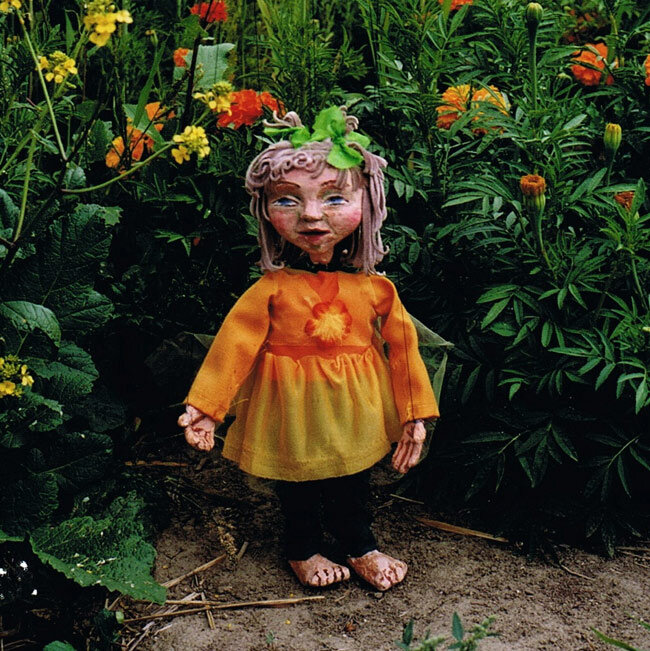The Faerie Play (2002)
The audience arrives just in time to see a play put on by five little children dressed as flower fairies, who are having a tea party and demonstrating their gardening tasks. All of the sudden delight turns to fright as we discover that the Dandelion Fairy child has gone missing! The audience is implored to help find her.
As the crowd sets out the land comes to life, with fairies everywhere trying to scare away the audience-intruders. Things get worse as they discover that the missing child has been shrunk by the real Dandelion Fairy to the size of the fairies and carried away by a crow.
The four little children take charge, leading the audience across a stream, through tall tall grass, and into a giant sunflower spiral. Throughout the story puppets, real fairies, and children-as-fairies are interchangeable, until the audience is released from Runaway Moon’s spell.
Poster Design by: Melody Anderson
A site-specific play through natural and deliberately planted settings, in which the audience became part of the story.
Core creation team Melody Anderson, Lois Anderson, Molly March, Cathy Stubington
Directed by: Lois Anderson and Peter Hall.
Puppets and costumes: Melody Anderson and Cathy Stubington.
Garden design: Molly March with farmer Doug Saba and gardener Mahina Rose; installations Julia Armstrong.
Performers: Sue Bertoia (as Miss Susan) puppeteers Lois Anderson, Cathy Stubington, Dayna Kneeland, Kendra Fanconi; Fairies Anouska and Elena Anderson-Kirby; Rosa, Leif, and Nell Saba
Stage Management: Dayna Kneeland
Funding from the Canada Council, the BC.Arts Council, The Leon and Thea Koerner Foundation, and BC Gaming Direct Access.
Remounted by Mortal Coil in Richmond B.C., 2015
Related productions: This was first of three site-specific shows through which we got to know our new venue of Curly Willow Farm: Faerie Play, A Winter’s Tale, Maize Show. All three brought the audience into the story.
Artistic Process
The “Faerie Play” was the first of three site-specific shows through which we got to know our new venue of Curly Willow Farm: Faerie Play, A Winter’s Tale, Maize Show.
As the snow melted and the season progressed, we explored the land and its features and wondered how we’d create a story that was a collaboration with the land. This play evolved from there.
Walking from the farm building and greenhouse at the entrance to the property, we discovered the trees as they leafed out, the grasses and bushes that grew and where; we recognized a little copse where a scene could play out. We discovered that there was a place where the stream could be crossed with a little help; we realized that an area of tall grasses made an interesting sound if you walked through them. This pathway suggested a shape to the story. Then we came to the open field where it felt that the story should end: Cathy had experimented with planting a spiral path of sunflowers the year before, and we decided to plant another one here, and that the story would culminate in the middle of the circle.
The story was created to fit this pathway through the land, by actor/puppeteer Lois Anderson, maskmaker Melody Anderson, scenic designer Molly March and puppeteer/maker Cathy Stubington. We had between us five small children, so rather than try and get away from them to be able to work on our project, we composed the story around them, and they became central to guiding of the audience through the pathway! With Sue Bertoia, Kendra Fanconi, Peter Hall , and Dana Kneeland filling in the cast, we rehearsed with both Lois and Peter directing scenes, and Molly making sure the story and setting were integrated. Farmer Doug Saba accommodated us by planting vegetables in the formations we needed and by planting the huge spiral path of sunflowers — so glorious!
--------------------------------------------
Synopsis:
The audience arrived in time for the flourishing beginning of a little play organized by the theatrically-inclined Miss Susan: five little children, dressed as fairies, are having a tea party. For the next scene, the fairy children usher the audience into the greenhouse to see their fairy gardening tasks and lead them through the 100-foot aisles of cucumber vines. On the other side, delight turns to fright as we discover that the Dandelion Fairy child has gone missing. Miss Susan implores the audience to help her find the child.
As the crowd sets out the land comes to life: they are tormented by fairies popping up behind flowering plants, trying to get them to go away. Led by Miss Susan they sneak past a tall fairy that guards a corn hedge, they’re chased down rows of irritated vegetables, and finally they escape through a scarlet runner bean archway into a shady glade, where they find out what has happened: the Real dandelion fairy (a puppet) has kidnapped the little girl, and has her captive in a tree. Bad goes to worse when the dandelion fairy makes a spell that shrinks the girl down to fairy size, and she’s carried away by a crow.
The four little fairy children take charge, leading the audience across a stream, through tall grass, and into a giant sunflower spiral (planted for this purpose) where dwells the giant snail Father Time. He calls all humans and fairies to a general assembly. Then, in a showdown between Miss Susan and the dandelion fairy, a reverse spell renews the little dandelion child to human size, and everyone leaves in a counterclockwise spiral out of the sunflower garden.



















